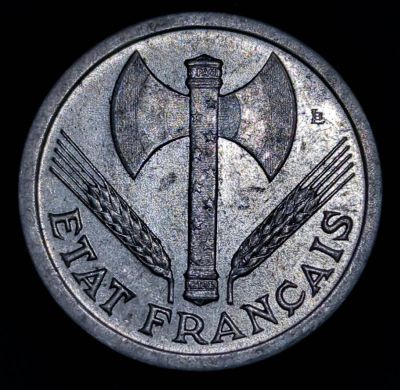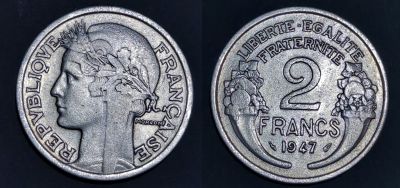A coin symbolic of a dark period in France

World War II
In May and June 1940, Nazi Germany invaded and captured not only France, but Luxembourg, the Netherlands and Belgium. In June 1940, unwilling to surrender, Paul Reynaud resigned as Prime Minister to be replaced by Philippe Pétain. On 22nd June, France signed an armistice with Germany. The result was German occupation of northern and western France, while the French government ostensibly controlled the south. With Paris under Nazi control, the administrative seat of government moved to the town of Vichy, spa resort, and home to Napoleon III’s personal villa. Pétain, a World War I hero, was given full and extraordinary powers, This effectively ended the Third Republic, creating “the Vichy French State”. While ostensibly neutral, Vichy France was, in practise, a German puppet government. In 1942, German and Italian forces took control of the rest of the country, until the liberation of France in 1944.
Obverse
During the German occupation of France, with everything else going on, everyday things like money were still needed. Previous issued contained the name of the republic and an image of Marianne, the embodiment of the Republic and the values “Liberty, Equality, Fraternity”. Coins issued under Vichy France, in some ways look similar, but are quite difference.
The obverse of this Vichy French State 2 Francs coin replaces the country name “REPUBLIQUE FRANÇAISE” (Republic of France) with “ÉTAT FRANÇAIS” (French State). The most obvious change, is the removal of Marianne, to be replaced with a double-headed axe. The axe has an ear of wheat to either side, a symbol which could be used to encourage nationalism and concentrating on your own farm, your own family.
Fasces
In fact, not simply an axe, the design is a “fasces”, from Latin, meaning “Bundle”. Originally a symbol from the Etruscan Civilization as far back as the 7th century B.C. The fasces was a bundle of wooden rods which included an axe, all held together with leather straps. It was an instrument for punishment, one intended to induce feelings of respect for the relevant authority as well as fear. The Roman Republic (and Empire) continued the use of the fasces both symbolically and literally. Attendants known as “Lictors” carried fasces and were a symbol of authority. An inscription from around AD 76, during the reign of the emperor Vespasian, tells us that the pool of lictors at Rome available for duty now numbered 370. Lictors with fasces functioned as the extension of the person of their superior. But the literary evidence suggests that they were notorious for engaging in gratuitous brutality on top of their fearsome official functions. The symbol continued to be used throughout history. There is a bronze statue of French king Louis XIV from 1689, resting his left arm on an axeless fasces topped by a helmet. In its context, the fasces conveys a balanced message of strength, dominion, moderation, and unity through reconciliation. 100 years later and the French Revolutionies who overthrew the monarchy took the fasces as their symbol.
Benito Mussolinias, founder and leader of the “Italian Fasci of Combat”, embraced the (previously pejorative) tag “fascisti” for his supporters, and used a threatening representation of the fasces to identify his party’s candidates. Use of the historical Roman emblem served as branding for his rapidly growing party, and to a stunning degree also helped valorize its violent methods, which intensified especially from Spring 1920.
Both for its traditional connotations, and in defference to Germany’s Axis, which included Mussolini’s Italy, use of the fasces on Vichy French coins would have been quite confronting for average French citizens in the 1940s.
Like the swastika, the fasces was used during and since WWII as a nazi, neo-nazi and white supremacist symbol. Following WWII, it was hastily removed from the US ten cent piece with the Mercury Dime being replaced by the Roosevelt Dime
Reverse

The reverse of the Vichy French 2 Francs coin has also been redesigned compared to earlier issues. The French Republic slogan “LIBERTE EGALITE FRATERNITE” (Liberty, Equality, Fraternity) has been replaced with “TRAVAIL FAMILLE PATRIE” (Work, family, fatherland).
The cornucopia found on previous 2 Franc coins is replaced with a pair of oak leaves. These have been used in military designs since Roman times to signify bravery and saving other citizens. They were also used on Nazi German SS uniforms and medals
The overall layout of the reverse of the coin is otherwise not dissimilar from previous issues.
Fourth republic
Following the liberation of France in 1944 and the return of the (now fourth) French Republic, the previous mottos and motifs were restored to French coins. Here is a 2 Franc coin from 1947, which looks quite similar to the pre-war issue.

Prior to WWII, the coins were minted out of copper-aluminium. The post-war republic coin still features the plain aluminium composition that was used during the war. Materials such as copper were still in short supply (article about the US, but that aspect was similar in Europe and around the world).


Leave a Reply